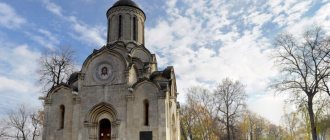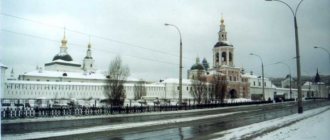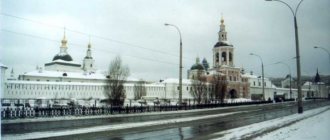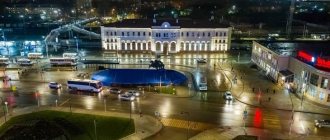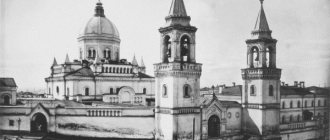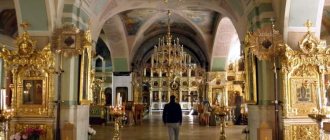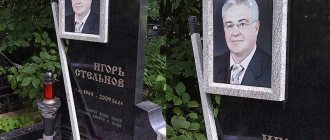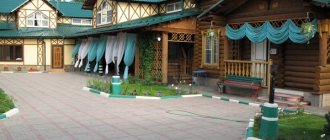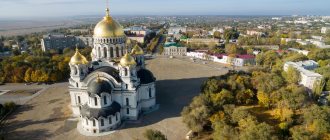The St. Danilov Monastery, or, as it is also called, Danilov or Danilovsky Monastery, was built at the end of the thirteenth century by Prince Daniil of Moscow. This monastery was attacked more than once and was almost completely destroyed. However, each time it was restored again.
The last time the monastery was closed was in 1918, after which an NKVD detention center was located there.
In 1982 L.I. Brezhnev decided to sign a decree on the restoration of the monastery and its return to the Russian Orthodox Church. And after that the monastery did not stop its work, being still active.
Story
The Danilovsky Monastery in Moscow was founded by Moscow Prince Daniil, the son of Grand Duke Alexander Nevsky. The prince was distinguished by piety, justice and mercy. He ruled for 30 years and during this time he managed to initiate the unification of the Russian lands around the future capital and became the first Moscow Grand Duke of All Rus'. Initially, a wooden church was built in the monastery in the name of St. Daniel the Stylite, patron of the holy prophet Daniel. Before his death, the prince took monastic vows. In 1303, he was buried, according to his will, in the simple brotherly cemetery of the monastery “not in the church, but in the fence.”
Frescoes in the summer church
The history of the Danilov Monastery is not simple. She had to endure many trials. In 1330, Daniil's son Ivan Kalita transferred it to the Kremlin, where it was safer from raids and assigned it to the Cathedral of the Savior on Bor. Then the monastery was moved to Krutitsky Hill. The Novospassky Monastery was built here. All this time the monastery remained desolate. It contained only a temple and a cemetery. The grave of Prince Daniel was abandoned. But the miraculous healings of parishioners visiting the grave of Prince Danil served to revive the monastery. Ivan the Terrible restored the ancient Danilovsky Monastery in Zamoskvorechye. The monastery was inhabited by monks. Previously subordinate to the Kremlin's Transfiguration Cathedral, it has now become independent again. And later, Prince Daniel was canonized and his incorruptible relics were found. Two days of remembrance of Saint Daniel were established - March 17, on the day of his death, and September 12, on the day of his discovery. relics (according to the old style this is March 4 and August 30).
The monastery was important in the defense of the capital. She played a big role in repelling the attack of the Crimean Khan Kazy-Girey in 1591. In troubled times, in 1606, rebels led by Bolotnikov were defeated by the army of Tsar Vasily Shuisky. In 1610, the impostor False Dmitry II set fire to the monastery. But soon it was rebuilt and surrounded by a beautiful stone wall with towers.
The fortress wall and the Gate Bell Tower with the Church of Simeon the Stylite
In beauty it could be compared with the fortress wall of the Kremlin. During the war with Napoleon, the monastery was plundered. A silver frame, created with a donation from Prince Fyodor Golitsyn, was stolen from the tomb of Saint Prince Daniel. In 1817, the holy relics of Prince Daniel were placed in a new silver shrine. After the revolution, during the persecution of the church, the monastery was also subjected to persecution and repression. The 300-year-old chapel was demolished. The Danilovsky Monastery in Moscow sheltered many clergy expelled from other churches for remaining faithful to the traditions of Russian Orthodoxy. They were called "Danilovites". Many of them were sent into exile or imprisonment. In 1930, the monastery in Moscow was closed, and some of the monks were shot. The relics of Saint Prince Daniel disappeared. Perhaps the believers themselves carried them away to save them from desecration. A monument to Lenin was erected on the territory. There was a children's colony and warehouses. The graves were opened. The remains of some famous figures were moved to other cemeteries. Danilovo cemetery was barbarically destroyed. In 1983, the monastery was returned to the Russian Orthodox Church. Its restoration begins, which was completed in time for the celebration of the 1000th anniversary of the Baptism of Rus' in 1988.
Relics of Saint Prince Daniel
Information about holy relics, revered icons and other shrines kept in the Danilov Monastery.
Most of the shrines currently kept in the Danilov Monastery were transferred to the monastery after its revival in 1983. A particularly large number of relics arrived in the mid-1980s, when Danilov was the only monastic monastery returned to the Russian Orthodox Church after an almost 70-year period of persecution. Believers perceived Danilov's discovery as the first news of the advent of the most favorable times for the Church. From all over the country, from existing churches, secular organizations, from bishops, clergy, and pious laity, the holy relics of the saints of God, ancient and new icons, and other sacred objects began to arrive at the monastery. Many shrines were given as donations. Several revered icons that belonged to the former Danilov, as well as particles of the relics of its founder, the blessed Prince Daniel, also returned to the monastery. This essay provides brief information only about the main monastery shrines.
The main shrine of the Danilov Monastery is the holy relics of its founder, Right-Believing Prince Daniil of Moscow. The relics of St. Daniel were discovered in 1652 and were kept in the monastery until 1930, when the last monastery church was closed. Then for some time they stayed in the Church of the Resurrection of the Word, which is next to the Danilov Monastery. In 1932, this temple was also closed, and the relics of the holy prince disappeared. Currently, in the Danilov Monastery there are several particles of the relics of St. Daniel placed in a shrine, an ark and icons.
Temples
To date, the monastery has been restored to the same form as it was in the 17th–19th centuries. The oldest of the monastery churches is the Church of the Holy Fathers of the Seven Ecumenical Councils.
Council of the Fathers of the Seven Ecumenical Councils
It was built in 1555–1560 and consecrated on May 18, 1561 by Metropolitan Macarius of Moscow in the presence of Tsar Ivan the Terrible. By the end of the 17th century, a refectory Church of the Intercession with a chapel in honor of the Prophet Daniel was built next to the temple. Later, the old temple was dismantled, and a new one was built at the beginning of the 18th century on the vaults of the Church of the Intercession, which became the lower floor of the Church of the Holy Fathers of the Seven Ecumenical Councils.
Lower Church of the Cathedral of the Fathers of the Seven Ecumenical Councils
At the beginning of the 19th century, the northern aisle appeared in the upper church - in the name of the blessed Prince Daniel of Moscow and the southern one - in the name of the holy passion-bearers, the blessed princes Boris and Gleb.
Chapel in the name of the blessed Prince Daniil of Moscow (northern)
The Church of the Intercession, located on the first floor, has a northern aisle in the name of the holy prophet Daniel, the heavenly patron of the Venerable Prince Daniel in monasticism. The patronal holiday is celebrated on October 14 (October 1, old style). After the late liturgy on this day there is a procession around the temple. In the 18th century, in the third tier of the Church of the Holy Fathers of the Seven Ecumenical Councils, a church was built above the porch in honor of the Monk Daniel the Stylite.
The largest cathedral in the Danilovsky Monastery is Trinity. Built in 1833–1838 according to the design of the architect O. Bove in the style of late Russian classicism at the expense of the Shustovs and Kumanins.
Trinity Cathedral
This is one of the last creations of the great architect. The throne was consecrated by Metropolitan Philaret of Moscow and Kolomna on September 13, 1838. At the same time, two chapels were consecrated. Northern - in honor of the conception of righteous Anna (northern). Southern - in honor of the Monk Alexy, the man of God. After the revival of the monastery, the throne in honor of the Holy Trinity was again consecrated on April 27, 1986. The patronal holiday - the day of the Holy Trinity, or Pentecost, is celebrated on the 50th day after Easter. The church has an iconostasis of the Kostroma school from the 17th century.
Iconostasis of the Trinity Cathedral
Here are the miraculous icons of the Mother of God “Three-Handed” and St. John Cassian the Roman. The gate church of St. Simeon the Stylite from 1732 has also been recreated.
Gate Church of Simeon the Stylite and bell tower
In the 1980s, in the chapel of the western doorway of the Holy Gate, in the basement of the hospital building, a church was built in the name of St. Seraphim of Sarov. On July 7, 1988, in the basement of the Trinity Cathedral, a church in the name of the Nativity of John the Baptist was consecrated. Its white stone iconostasis, decorated with rich carvings, is noteworthy. On holidays, the Sacrament of Confession is performed here. The architect Alonov built a chapel over the warehouse in honor of the 1000th anniversary of the Baptism of Rus' on the square of the Danilovsky Monastery.
Nadkladeznaya Chapel and the Cathedral of the Fathers of the Seven Ecumenical Councils
It has not yet been possible to find the graves destroyed during the demolition of the cemetery. A symbolic monument to all those buried was the chapel-ossuary - a memorial chapel, built in 1988 according to the design of the same architect Alonov. Near the graves of Gogol and Khomyakov, two bas-reliefs were installed in their memory. On September 4, 1997, during the celebration of the 850th anniversary of Moscow, a monument to the holy noble prince Daniil of Moscow was opened and consecrated on Tula Square. And soon a chapel was consecrated in his honor. In 2003–2008, 18 bells were returned, which in the 1930s were bought by American industrialist Charles Crane and donated to Harvard University to save them from being melted down. The main shrine of the monastery is particles of the relics of Saint Prince Daniel of Moscow. They are located in the Trinity Cathedral and the Church of the Holy Fathers of the Seven Ecumenical Councils.
Directions to the Danilovsky Monastery
There are several ways to get to the Danilovsky Monastery. We list all available ones.
By car
If you have a personal car, then this will not be difficult for you. The most convenient way, taking advantage of modern technologies, is to use a navigator, indicating in it the destination - the Danilovsky Monastery.
If you don’t have a navigator, then study the map before your trip - once you familiarize yourself with its location, getting to the monastery will not be a problem. In any case, if necessary, you can ask passers-by for directions. If you have to get there by public transport, then below we describe how to get to the monastery by metro and tram.
By tram
You can get to the Danilovsky Monastery, as already mentioned, by tram. The following routes: A, 3, 35, 38 will take you to the “St. Danilov Monastery” stop. The name of the stop speaks for itself - let's get off.
- If you are coming from the railway, from the ZIL station, then the following tram route numbers are suitable for you: 35 and 3. You need to travel a little - only three stops.
- If you go from the Nizhnie Kotly station, then you need all the same route numbers, but you will have to travel a little more - seven stops. Get off at the St. Danilov Monastery stop.
- If you get there from Paveletsky Station, then you need to take the tram to the stop called Danilovsky Val Street. You need to go seven stops. Suitable route numbers are 3, A and 39.
Metro
The easiest and fastest way to get to the monastery is by metro. If you chose this particular path, then your branch is Serpukhovsko-Timiryazevskaya, get on and get to the Tulskaya metro station. If you are traveling from the center, it is more convenient to take the last car.
To Tulskaya station
When you exit the metro, turn back, and when you reach the tram tracks, turn right - this will be Danilovsky Val Street. Walk further, without turning, along the tram tracks, and you will come straight to the gates of the Danilovsky Monastery. The journey will take about 10 minutes if you walk at an average pace.
To Paveletskaya station
In addition, by getting off at the Paveletskaya metro station, you can also get to the Danilov Monastery.
However, then you will also need to travel by tram, because the walk is quite far - about 2.5 km. Take any route and get to the same tram stop “Svyato-Danilov Monastery”.
St. Daniel's Monastery is open to visitors. It has a complex and at the same time rich history and great architectural value. All buildings located on its territory have been restored, the territory itself is well-groomed and beautiful.
Therefore, even a simple walk through the Danilovsky Monastery can be fascinating and interesting.
Tourist information
The Danilovsky Monastery in Moscow is stauropegial, that is, its abbot is His Holiness the Patriarch of Moscow and All Rus'. Everyday life is managed by his viceroy in the rank of archimandrite. The monastery, according to its charter, is communal, which means common prayer, work and meals for the monks. The brethren of the monastery participate in charity and mercy works in hospitals, children's institutions and in places of detention. In addition, teaching is carried out in secular and religious higher educational institutions.
There is a Sunday school and catechetical courses for adults (the doctrine of the Orthodox faith is taught). The Danilovsky Blagovestnik publishing house and various workshops are located here. There is a tour service. There are farmsteads in the Ryazan region and in the Moscow region. There is a church of St. Nicholas in Izmailovo, which is the tallest wooden church in Russia. Its height is 46 meters.
Flowerbed and Nagornaya Tower
How does the monastery live today?
Modern rich monastic life
The monastery Patriarchal male choir has been famous for many years. It consists of 16 talented singers. Taking part in Sunday and all holiday services, often going on tours in different cities, the choir of the Danilov Monastery gained fame far beyond the borders of its monastery.
The brethren of the Danilov Monastery perform charitable and merciful deeds in medical and children's institutions, conduct lessons in schools and other educational institutions.
Social service
For people suffering from alcohol and other addictions, a help center called “Metanoia” has been specially created in the monastery. The unique program “Orthodox Internet Course” (PIC) for distance learning for people who want to learn more about Orthodoxy, strengthen their faith in God, and answer their pressing questions was created by employees of the Patriarchal Center for the Spiritual Development of Children and Youth of the St. Daniel Monastery.
There is also a volunteer service here.
Since volunteers often visit children's schools, hospitals, and boarding schools, it is very important for them to know and be able to apply the basic rules of communication with children. And when communication takes place interspersed with games, getting to know each other and spending time together becomes more interesting and useful for everyone
All this, and not only this, is taught in the “Game Modeling Workshop” at the Danilov Monastery.
Guests are welcome here!
In the store located right there, you can buy and try your own products produced at the local bakery: very fresh and tasty pastries! You can also buy dairy products brought from more distant monasteries.
In general, before entering you can find a lot of interesting and useful things.
At the entrance to the monastery territory there is a special locker with women's scarves and skirts. A woman's lack of a headscarf or a very short dress are not welcome here. However, as in all church institutions.
The Moscow St. Daniel's Stavropegic Monastery stores a lot of wonderful and beautiful things, so majestic that emotions simply overwhelm! Come and see for yourself!
Residence of the Patriarch
In the western part of the monastery complex there is a specially protected object - the Synodal residence of the patriarch. The two-story building was built according to the design of Yuri Rabaev, one of the authors of the Tomb of the Unknown Soldier near the Kremlin walls. As a result of his efforts, a classic regional party committee was created with elements of church architecture - tent towers and mosaics depicting the Savior. On the second floor of the residence there is the house church of All Saints. Here the naming of bishops is carried out before the new Orthodox hierarch is consecrated in the Cathedral of Christ the Savior. In 2011, the Synodal Residence was completely renovated, explaining this need by imperfect construction technologies of 25 years ago.
Residence of the Patriarch
This is interesting: Report on the Battle of Kulikovo
Divine services
On patronal feast days, divine services are held in churches. In the Trinity Cathedral, on the twelfth feast of the Holy Trinity, as well as on holidays and Sundays, an all-night vigil and late Divine Liturgy are held. In the Church of the Holy Fathers of the Seven Ecumenical Councils, weekday services and early holiday liturgies are held. In other monastery churches, the early Divine Liturgy is served on the days of their patronal feast days. Before the early liturgy there is a water prayer service.
The Danilovsky Monastery is the seat of the residence of His Holiness the Patriarch of Moscow and All Rus'. Bishops' Councils of the Russian Orthodox Church are held here.
Description of the complex
The complex of structures that can be seen today was formed four centuries ago. At the end of the last century, auxiliary premises necessary for the work of the DECR were built.
Upon returning to his native place, Archimandrite Eulogius became the first governor. Slowly everything began to be revived and restored. Finance for this was provided by local church parishes and dioceses of the Patriarchate. At the same time, a special commission was even appointed, which was responsible for restoration work; it was headed by the famous architect Makovetsky.
Divine services began to be held again in the early 80s of the last century. And in the spring of 2007, the ensemble of bells from the belfry was returned here. This was helped by entrepreneur Vekselberg, who covered all project costs.
Monastery churchyard
During the reign of Catherine the Second, when a plague epidemic broke out, the epicenter of which was Moscow, St. Daniel's Monastery became the burial place for those who died from this disease, since it was located far from the central regions of the capital. When the plague subsided, the cemetery was covered with earth. Since those ancient times, the tradition of burying both monks and laity in the monastery has remained. Over time, a cemetery appeared here, where noble and rich people were buried. In the graveyard of the Danilovsky Monastery, musician N. G. Rubinstein, who is the founder of the Russian Musical Society, found his last refuge; Slavophiles A. S. Khomyakov and Yu. F. Samarin, artist V. G. Perov and the most famous of the laity - N. V. Gogol. The coffin and his body were brought here in their arms from the Tatiana Church at the University on Mokhovaya, where the deceased was buried as an honorary member of Moscow University. However, in 1953, the remains of the great writer were moved to the Novodevichy cemetery.
Interesting facts and legends
According to legend, a servant of Ivan III was thrown off by a tripping horse near the abandoned burial place of Prince Daniil. The fallen man had an amazing vision of the Great Prince of Moscow, who said reproachfully that “he is the master of this place, placed here.” He ordered to tell Ivan that the king had forgotten about Daniel. Ivan III was frightened when he heard the story of his servant.
And from that incident, they began to hold regular memorial services for all deceased ancestors and give rich, generous alms to remember the soul. Later, another interesting incident occurred in this place, when boyar Shuisky could not get on his horse. He leaned on the tombstone to get higher.
An old man passing by reprimanded him that he should not stand on the grave of the Grand Duke of Moscow. But the boyar did not listen and began to climb onto the tombstone. Suddenly the horse falls dead, almost crushing its owner to death.
Under Ivan the Terrible, a miracle occurred at this tombstone - the healing of a dying man. The royal command established the tradition of religious processions every year to the burial place of the great ancestor, with a regular memorial service for him.
